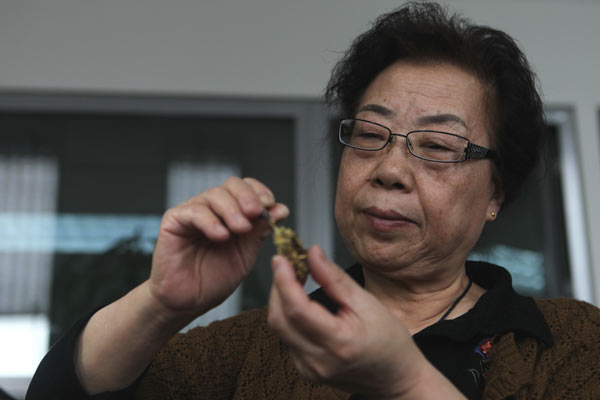Imperial skill gets a modern twist
Updated: 2011-05-25 07:52
By Mei Jia (China Daily)
|
|||||||||||
Bai Jingyi says she never dreamt of becoming a master in jewelry craftmanship but it has become a part of her life. PHOTOS BY WANG JING / CHINA DAILY

A talented craftswoman is making haute couture jewelry with ancient Chinese characteristics, Mei Jia reports.
We have all heard of haute couture jewelry from Paris or Milan, which means large sums of money and piles of charm. But did you know Beijing has its own haute couture jewelry, made in an almost lost art form passed down from generations of royal craftsmen?
Bai Jingyi, 69, believes traditional craftsmanship should not be left to rest quietly in museums, but should be shining its own strong light.
By using old skills to create accessories with modern appeal, Bai is trying to revive royal filigree and inlay, which was exclusively applied to jewelry and ornaments made for China's imperial families.
Royal filigree and inlay is among the eight superb crafts of Beijing. Its early forms appeared some 2,700 years ago. The craft reached its peak during the Ming Dynasty (1368-1644).
These artifacts required expensive raw materials and exquisite workmanship from highly trained craftsmen. Bai said that in those days only the imperial family could afford such luxuries.
On some of the old pieces collected by the Palace Museum, such as watches, there are human figures the size of a grain of rice. But the eyelashes can be seen clearly. And if you look closely, the eyes in some are black and in others blue.
After the 1911 Revolution, the craftsmen scattered and their skills were applied to luxury items for export or for the rich. From the 1950s to 2002, a handicraft factory in Tongzhou district employed some craftsmen to make diplomatic gifts for foreign nations.
Bai was one of these craftsmen. With its strict training system, the quality of work made at the factory reached new heights in the 1970s and 1980s. But the glory faded as the factory failed to adapt to a market economy and changing trends.
Now a few of the old masters, retired from the factory, are still practicing the skill, and a few young people are willing to learn from them.
The craft was listed among the nation's intangible cultural heritages in 2008, and Bai was made the "representative inheritor" of the heritage. She now runs a Master's Workshop at Tongzhou.
Bai invited some of her old colleagues, some of whom were making a living by repairing bikes, to resume their craft.
The skill is actually a combination of two: filigreeing and inlaying.
"It's rare internationally, even in history, to combine the two skills," Bai told METRO, in her tidy three-story workshop.
"One thing special about royal filigree inlay is that, even after being told the secret of every detail, without years of training a craftsman cannot master the skill," she said.
Filigree is applying nipping, plaiting, filling, jointing, piling and other handiwork to form various shapes out of very fine gold and silver threads. Inlay is to work gold or silver slices into different shapes, patterns or containers. Other skills add colors and precious stones.
Bai said making one piece requires the cooperation of many craftsmen, for it is only possible for one person to master one process.
A replica of an empress' phoenix cap from the Ming Dynasty, designed by Bai and finished by the workshop in 2010, took all the craftsmen two years.
Bai had to refer to numerous files to draw the design, inseveralhundreddrafts, and even imagined the design for the back, as most file photos show only the front.
Bai also designed an emperor's dragon cap, which was light in weight with no signs of any joins or welding. Six craftsmen took a year to do the plaiting.
Bai comes from a big Manchu family steeped in traditional culture. Her childhood dream was to become an established painter.
As a girl, she often missed school classes to stand for hours in front of paintings in museums, trying to memorize shapes and colors.
"I never dreamt of being a master in the crafts," she said. "But it defines me; it became a part of my life. While other people watch TV series, I look at the patterns and styles."
She keeps her designs up to date by using such contemporary sources. And she is keen to keep royal filigree and inlay alive in the modern jewelry she designs.
"We're creating haute couture jewelry with Chinese characteristics," she said.
(China Daily 05/25/2011 page)